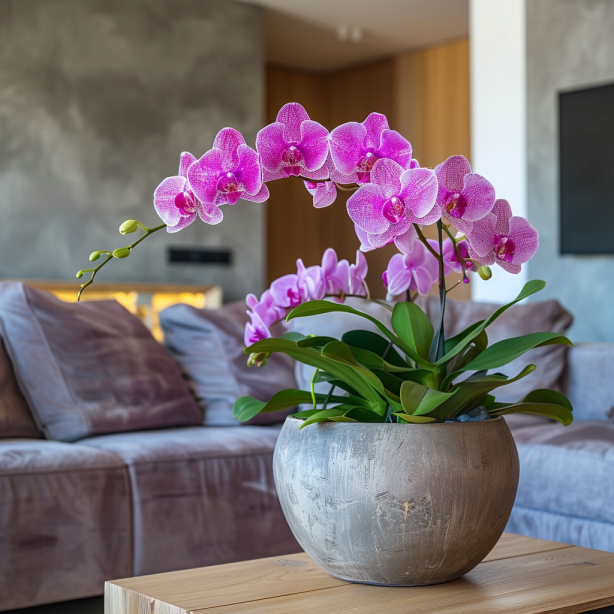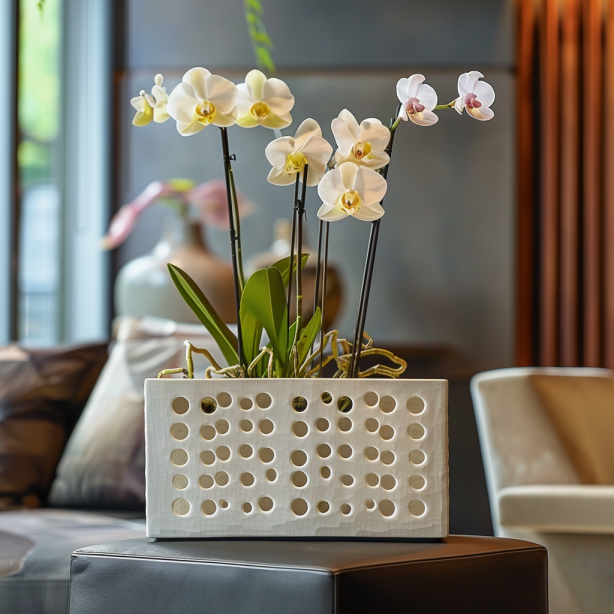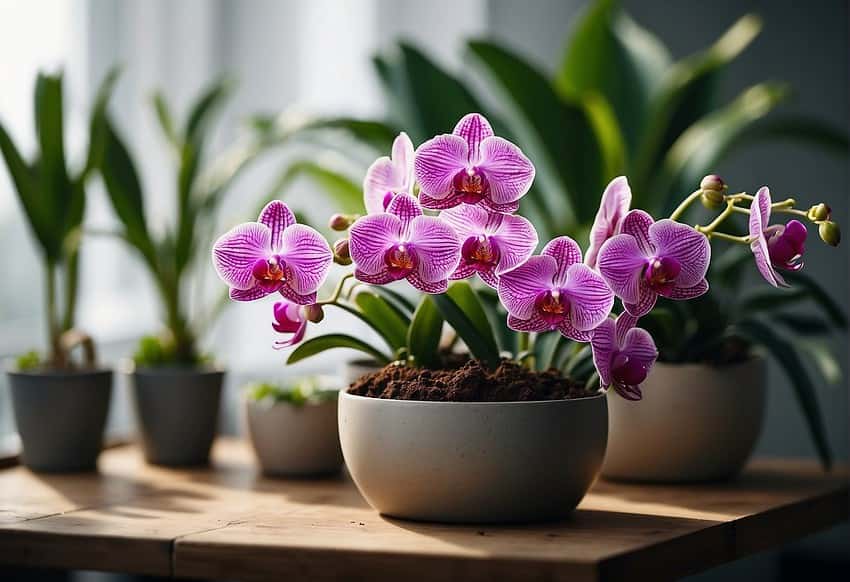Growing orchids in pots is a popular approach to cultivating these exotic plants. This allows for better control over the conditions necessary for their growth.
In container gardening, considerations for pot size, material, and design are vital. These factors directly influence root health, moisture levels, and air circulation.
Most orchids are epiphytic, meaning they grow on other plants instead of in the soil. So the right container mimics these conditions, providing support and the right environment for healthy growth.

Orchids require specific potting mediums and containers with adequate drainage to thrive. While aesthetics can play a part in the selection of orchid pots, it is crucial to prioritize the functional aspects that cater to an orchid’s root system, which is prone to rot if left in standing water.
A variety of materials are used for orchid pots, each with its own set of benefits that can cater to the specific needs of different orchid species.
Understanding the correlation between the type of orchid and the most suitable pot is essential for any gardener looking to succeed in growing orchids in containers.
With the proper knowledge and tools, gardeners can cultivate vibrant, blooming orchids indoors or outdoors. This recreates the epiphytic growing conditions these plants are accustomed to in nature.
Understanding Orchids

Orchidaceae, commonly known as orchids, represent a vast and diverse family of flowering plants. With over 25,000 species, they exhibit incredible variety in size, shape, and habitat preferences. They are found on every continent except Antarctica, thriving in areas from jungle environments in South America to arid regions in Africa and temperate Europe.
Most orchids are epiphytes, meaning they grow on the surface of other plants, typically trees, and derive moisture and nutrients from the air and rain. Epiphytic orchids have unique adaptations, such as specialized aerial roots with a covering called velamen that absorbs water efficiently.
Orchids possess several key features that distinguish them from other plant species:
- Flowers: Orchids’ flowers are often symmetrical, and many species boast vivid colors and patterns.
- Roots: Aside from epiphytic roots, some orchids develop tuberous roots for storing nutrients.
- Leaves: Orchid leaves vary significantly, from thin and small to fleshy and large, depending on their habitat.
Orchids conduct a delicate dance with their environment, many having evolved intricate pollination mechanisms involving specific pollinators. This specialization aids in the survival of orchids in diverse conditions but also creates vulnerability; if their pollinator is scarce, their ability to reproduce can be compromised.
Understanding the needs and characteristics of orchids is essential when considering them for container gardening. Providing a mimicry of their natural conditions is pivotal to their health and bloom—a process that requires attention to detail but can be exceptionally rewarding.
Benefits of Container Gardening for Orchids

Container gardening offers several advantages for cultivating orchids. This method mirrors an orchid’s natural environment, providing several critical benefits that are essential for their health and growth.
Improved Drainage: Crucial for orchid health, proper drainage can be controlled and optimized with containers. As highlighted by Epic Gardening, adequate drainage holes in the pots prevent water logging, simulating the conditions these plants would encounter in their native habitats.
Enhanced Air Circulation: Orchids thrive with good airflow around their roots. The right orchid containers, such as those made of porous materials like clay, facilitate this, contributing to healthier root systems.
Flexibility in Potting Mix: Each orchid species has specific requirements for its potting mix. Container gardening allows gardeners to tailor the potting medium to suit the individual needs of their orchids, optimizing growth.
Portable Environment: Pots make it easier to move orchids to different locations based on their light and temperature requirements. During adverse weather or unfavorable seasonal changes, orchids can be readily transported to more suitable conditions.
Aesthetic Value: Orchids in containers can be a decorative element in living spaces. The range of container styles provides additional charm and complements the orchid’s beauty.
Size Management: Containers help in managing the size of orchid plants. By selecting an appropriately sized pot, growers can control the growth and shape of their orchids, ensuring that they do not become too large for their space.
Selecting the Right Pot for Your Orchid
When growing orchids, the selection of the appropriate pot is crucial for ensuring the health and beauty of these plants. Specifics like material, size, and drainage capabilities will have direct effects on the root system and overall growth.
Materials and Types
The material of an orchid pot greatly influences the plant’s access to air and moisture.
Terracotta pots are porous, aiding in air circulation and moisture evaporation. They are a reliable choice for most orchids, preventing waterlogging and root rot.
However, plastic pots are lighter and retain moisture longer, which can be beneficial or detrimental depending on the orchid species and environment.
Clear plastic pots are popular as they allow sunlight to reach the roots and enable easy monitoring of the plant’s health.
- Terracotta: Porous, promotes air circulation, quick drying.
- Plastic: Lightweight, retains moisture, and may restrict airflow if not properly designed.
- Clear Plastic: Enables photosynthesis at the root level and facilitates health checks.

Importance of Size and Shape
Choosing the correct size and shape of an orchid pot is vital.
An overly large pot can cause the medium to stay wet too long, while a small pot may not provide enough room for root growth.
Orchids prefer a snug fit, so selecting a pot that accommodates the current root mass and a little extra growth space is ideal.
Traditional pots are often suitable, but orchid pots sometimes feature a tapered shape to allow for the unique growth patterns of orchid roots.
- Sizes: Match the pot to the current root mass plus a bit of growth space.
- Shape: Consider tapered designs for orchid-specific growth needs.
Understanding Drainage Needs
Drainage is arguably the most critical aspect of an orchid pot.
Orchids require pots with excellent drainage holes to prevent root rot.
Some orchid pots feature a lacework of holes or slats, which provide superior water drainage and air flow to the roots.
In decorative containers, ensure that the orchid remains in its grower pot with drainage holes, possibly set inside the more attractive outer pot.
- Drainage Holes: Essential to prevent waterlogging and root diseases.
- Mesh or Slats: Provide extra air flow and prevent excess water buildup.
Potting Mediums for Orchid Health
The health of an orchid is significantly influenced by the potting medium used, as it affects moisture retention and aeration and supports root health. The right medium balances the orchid’s needs for both water and airflow.
Choosing the Right Mix
When selecting a potting mix for orchids, consider a variety of materials like bark, sphagnum moss, charcoal, and perlite.
A common choice is a bark-based mix, which provides good drainage and air circulation but may decompose over time.
Alternative components, such as moss and charcoal, can customize the mixture to the specific needs of different orchid types.
- Bark: Allows for excellent drainage and mimics the orchid’s natural habitat.
- Sphagnum Moss: Retains moisture effectively and is useful for drier environments.
- Charcoal: Adds to the mix’s drainage capabilities and helps filter impurities.
- Perlite: Ensures aeration and moisture retention without compacting over time.
Role of Moisture Retention
Controlling moisture is a delicate balance that impacts orchid health.
Orchids should not sit in waterlogged soil, which can lead to root rot. Instead, the potting medium should retain sufficient moisture between watering cycles.
- Sphagnum Moss: Offers superior moisture retention, which is beneficial for species requiring a more humid environment.
- Bark: Less moisture-retentive, suitable for orchids that prefer drier conditions.
Aeration and Air Circulation
Aeration within the potting medium is crucial for healthy orchid roots.
Adequate air circulation facilitates gas exchange and prevents fungal and bacterial infections.
- Bark: Creates natural air pockets around the roots.
- Perlite: Introduces more air spaces, improving the overall airflow in the potting mix.
- Moss: Should be used sparingly as it can compact and reduce air circulation if overused.
Orchid Care in Containers

Growing orchids in containers successfully requires attention to specific factors such as watering, fertilization, and the creation of an ideal microclimate that includes appropriate temperature, humidity, and light.
Proper maintenance, including timely repotting, is also crucial to nurture healthy plants.
Watering Techniques
Orchids should be watered thoroughly but allowed to dry out between waterings.
The frequency of watering largely depends on the container material.
For instance, those grown in plastic pots may retain moisture longer and thus require less frequent watering compared to clay pots, which allow for more evaporation.
Fertilizing for Growth and Bloom
Fertilize orchids regularly during the growing season using a balanced fertilizer. Implement a “less is more” approach, as over-fertilization can harm the roots.
During the dormant period, reduce fertilization to support natural growth rhythms.
Temperature and Humidity Control
Maintaining a humidity level between 40% to 70% is optimal for orchids.
Indoor growers may use humidifiers or trays filled with water and pebbles to increase moisture in the air.
Orchids prefer a stable temperature range conducive to their specific variety, typically between 60-85°F (15-29°C).
Lighting Requirements
Provide orchids with bright, indirect light without exposing them to direct sun to mimic their natural habitat.
East or south-facing windows covered with sheer curtains are ideal sources of light for most orchids.
Repotting and Maintenance
Repot orchids every two to three years to refresh the potting mix, inspect root health, and possibly graduate to a larger size pot if the orchid has outgrown its former container.
Clear pots can be beneficial to monitor root health and moisture levels.
During repotting, it’s the perfect time for some light pruning with sterilized pruning shears to remove any dead or rotting roots.
Avoiding Common Pitfalls

Successfully growing orchids in pots requires careful attention to several critical factors to prevent common issues that can hinder plant health and growth.
Thorough understanding and management of watering routines, pest control, and environmental placement can significantly improve the chances of cultivating flourishing orchids.
Preventing Overwatering and Root Rot
Overwatering is one of the most prevalent problems in orchid care, leading to root rot.
Orchids require pots with excellent water drainage to prevent water from pooling around the roots.
A good practice is to:
- Use containers with multiple drainage holes.
- Select a potting medium that facilitates rapid water passage.
Monitoring humidity levels is also crucial since high humidity combined with poor drainage can create an environment conducive to root rot.
Dealing with Pests and Diseases
Orchids can fall prey to various pests and diseases.
Vigilance in pest control is essential. Regular inspections of the leaves and roots can catch problems early, when they are most manageable.
If pests are detected, one should:
- Isolate the infected plant to prevent spread.
- Apply an appropriate treatment, such as insecticidal soap for pests like mites or neem oil for aphids.
Fungal and bacterial diseases require reducing humidity and improving air circulation around the plant as preventive measures.
Optimal Orchid Placement
Light and temperature are pivotal for orchid health.
Orchids should be placed in an area that mimics their natural environment—which is typically:
- Bright, indirect sunlight.
- Stable temperatures, avoiding cold drafts or excessive heat.
Adequate light promotes healthy growth and bloom formation, while stable temperatures help maintain robust root health and overall plant vitality.
Careful positioning in the home or greenhouse is key to ensuring that these needs are met.
Orchid Pot Decoration and Display

Growing orchids in pots not only provides the necessary environmental conditions but also offers opportunities to enhance your home decor.
Thoughtfully chosen containers and strategic displays can integrate these exotic blooms into your living spaces beautifully.
Choosing Decorative Containers
When selecting decorative containers for orchids, one should consider both aesthetic appeal and orchid health.
Transparent pots are often recommended, as they allow for sunlight to reach the roots and make it easier to monitor the moisture levels of the planting medium.
However, ceramic pots and other decorative containers serve as attractive options and can complement any interior design scheme.
Decorative Container Examples:
- Clear Plastic Pots: Ideal for monitoring root health and moisture.
- Ceramic Pots: Aesthetically pleasing and available in various colors.
- Decorative Baskets: Natural look, suitable for hanging displays.
Using Outer Pots and Saucers
Combining a functional inner pot with an outer pot and saucer adds a decorative touch while still catering to an orchid’s needs.
The outer pot provides the decorative appeal, while the saucer catches excess water, protecting furniture surfaces.
Lightweight options such as plastic or decorative containers specifically made for orchids can offer the right balance of practicality and style.
Pot and Saucer Considerations:
- Ensure the outer pot is slightly larger than the inner pot for easy removal.
- Select a saucer that corresponds with the outer pot’s size to catch water runoff.
Types of Orchids and Their Container Needs

Selecting the appropriate container for an orchid is as vital as choosing the right potting medium.
Different orchid species have unique requirements for container gardening, which are essential for providing the best environment for growth and bloom.
Popular Orchid Species for Pots
Phalaenopsis: Often known as “moth orchids,” these are widely favored for indoor cultivation.
They thrive in clear or semi-transparent pots allowing for adequate light to reach their roots. A potting medium of bark chips enhances air circulation, crucial for root health.
Cattleya: These orchids prefer slightly larger pots that provide enough room for their robust root systems.
Excellent drainage is essential, along with a potting medium that dries out between waterings to prevent root rot.
Dendrobium: This species is diverse, with some types preferring tall containers that support their long cane-like growth.
Mediums such as cork or lava rock can assist in providing the necessary drainage and aeration.
- Phalaenopsis: Clear pots, medium air circulation.
- Cattleya: Larger pots, good drainage.
- Dendrobium: Tall containers, well-draining medium.
Special Considerations for Epiphytic Orchids
Epiphytes, including many cattleya and dendrobium hybrids, naturally grow on trees and other hosts.
They require pots that mimic their natural habitat:
- Orchid pots with numerous holes for air circulation.
- Containers that allow for a drier potting medium, like bark or moss.
- Consideration for a more frequent watering schedule due to the potting medium’s quick-drying properties.
Creative Orchid Container Ideas

When selecting a decorative container for orchids, one must consider both functionality and aesthetics.
Orchids thrive when their unique root systems are accommodated, so the choice of material is crucial.
- Terracotta Pots: These classic pots are porous, allowing roots to breathe and preventing water from stagnating. Their earthy tones also complement the vibrant orchid blooms.
- Clear Plastic Pots: Orchids’ roots are photosynthetic; thus, clear pots permit sunlight to reach the roots, providing a health benefit as well as a modern look.
- Wooden Baskets: Using a basket lined with bark chips allows for ample air circulation, imitating the orchid’s natural growing environment on tree branches.
- Decorative Pot Covers: Insert a functional pot inside a stylish decorative pot to meld practicality with home decor trends.
Here are some creative ideas for orchid containers:
- Chalkboard Painted Pots: Personalize a terracotta pot with chalkboard paint for a fun, customizable look. Learn more on Epic Gardening.
- Hanging Planters: Utilize vertical space by creating a hanging orchid display, perhaps using a piece of driftwood for a natural feel. Find inspiration at Balcony Garden Web.
- Repurposed Items: Items such as teacups, mason jars, or even wine glasses can become unique orchid containers. Just ensure proper drainage and room for growth.
Frequently Asked Questions

In the world of orchid care, making the right choices for container gardening is crucial. These frequently asked questions address the essential considerations for selecting pots, potting mix, and understanding repotting schedules for orchid plants.
What factors should be considered when choosing a potting mix for orchids?
One must ensure the potting mix provides adequate drainage and aeration.
Certain orchid-specific blends cater to these needs, mimicking their natural epiphytic conditions.
How do I select the right size orchid pot for optimal growth?
The pot size should accommodate the orchid’s root system while allowing for growth. A pot too large can retain excess moisture, leading to root rot. Meanwhile, a pot too small may restrict growth and dry out too quickly.
Can ceramic pots be used for orchids, and what are the benefits over other materials?
Ceramic pots are suitable for orchids due to their weight, which provides stability, and their porous nature, which helps with aeration and moisture control. The chief benefit of ceramic pots is their aesthetic appeal combined with functional characteristics conducive to orchid health.
What are the pros and cons of using transparent pots for orchids?
Transparent pots allow for monitoring root health and moisture levels easily. However, they can also promote algae growth if not properly managed, which can be detrimental to the orchid’s roots.
How often should orchids be repotted, and what signs indicate it’s time?
Orchids generally require repotting every 1-2 years. Signs such as overflowing roots, slow growth, or a breakdown of potting media suggest that it’s time to repot.
What are innovative container ideas that can support orchid health and flowering?
Beyond the usual pots, orchids can thrive in mounted setups or in specialized orchid baskets. These baskets promote airflow around the roots, simulating their natural growing conditions and supporting overall plant health.


